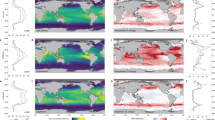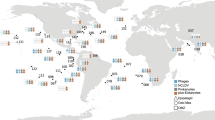Abstract
Although the oceans cover 70% of the Earth's surface, our knowledge of biodiversity patterns in marine phytoplankton and zooplankton is very limited compared to that of the biodiversity of plants and herbivores in the terrestrial world. Here, we present biodiversity data for marine plankton assemblages from different areas of the world ocean. Similar to terrestrial vegetation1,2,3, marine phytoplankton diversity is a unimodal function of phytoplankton biomass, with maximum diversity at intermediate levels of phytoplankton biomass and minimum diversity during massive blooms. Contrary to expectation, we did not find a relation between phytoplankton diversity and zooplankton diversity. Zooplankton diversity is a unimodal function of zooplankton biomass. Most strikingly, these marine biodiversity patterns show a worldwide consistency, despite obvious differences in environmental conditions of the various oceanographic regions. These findings may serve as a new benchmark in the search for global biodiversity patterns of plants and herbivores.
This is a preview of subscription content, access via your institution
Access options
Subscribe to this journal
Receive 51 print issues and online access
$199.00 per year
only $3.90 per issue
Buy this article
- Purchase on Springer Link
- Instant access to full article PDF
Prices may be subject to local taxes which are calculated during checkout




Similar content being viewed by others
References
Grime, J. P. Competitive exclusion in herbaceous vegetation. Nature 242, 344–347 (1973)
Tilman, D. Resource Competition and Community Structure (Princeton Univ. Press, Princeton, 1982)
Rosenzweig, M. L. Species Diversity in Space and Time (Cambridge Univ. Press, Cambridge, 1995)
Waide, R. B. et al. The relationship between productivity and species richness. Annu. Rev. Ecol. Syst. 30, 257–300 (1999)
Mittelbach, G. G. et al. What is the observed relationship between species richness and productivity? Ecology 82, 2381–2396 (2001)
Chase, J. M. & Leibold, M. A. Spatial scale dictates the productivity–biodiversity relationship. Nature 416, 427–430 (2002)
Fukami, T. & Morin, P. J. Productivity-biodiversity relationships depend on the history of community assembly. Nature 424, 423–426 (2003)
Williams, L. Possible relationships between plankton-diatom species numbers and water-quality estimates. Ecology 45, 809–823 (1964)
Dodson, S. I., Arnott, S. E. & Cottingham, K. L. The relationship in lake communities between primary productivity and species richness. Ecology 81, 2662–2679 (2000)
Kassen, R., Buckling, A., Bell, G. & Rainey, P. B. Diversity peaks at intermediate productivity in a laboratory microcosm. Nature 406, 508–512 (2000)
Interlandi, S. J. & Kilham, S. S. Limiting resources and the regulation of diversity in phytoplankton communities. Ecology 82, 1270–1282 (2001)
Li, W. K. W. Macroecological patterns of phytoplankton in the northwestern North Atlantic Ocean. Nature 419, 154–157 (2002)
Calbet, A. & Landry, M. R. Phytoplankton growth, microzooplankton grazing, and carbon cycling in marine systems. Limnol. Oceanogr. 49, 51–57 (2004)
Agawin, N. S. R., Duarte, C. M. & Agustí, S. Nutrient and temperature control of the contribution of picoplankton to phytoplankton biomass and production. Limnol. Oceanogr. 45, 591–600 (2000)
Joint, I. & Groom, S. B. Estimation of phytoplankton production from space: current status and future potential of satellite remote sensing. J. Exp. Mar. Biol. Ecol. 250, 233–255 (2000)
Margalef, R. Life-forms of phytoplankton as survival alternatives in an unstable environment. Oceanol. Acta 1, 493–509 (1978)
Raven, J. A. Small is beautiful: the picophytoplankton. Funct. Ecol. 12, 503–513 (1998)
Strom, S. et al. Chemical defense in the microplankton. I. Feeding and growth rates of the heterotrophic protists on the DMS-producing phytoplankter E. huxleyi. Limnol. Oceanogr. 48, 217–229 (2003)
Hamm, C. E. et al. Architecture and material properties of diatom shells provide effective mechanical protection. Nature 421, 841–843 (2003)
Huisman, J., Jonker, R. R., Zonneveld, C. & Weissing, F. J. Competition for light between phytoplankton species: experimental tests of mechanistic theory. Ecology 80, 211–222 (1999)
Huisman, J., van Oostveen, P. & Weissing, F. J. Species dynamics in phytoplankton blooms: incomplete mixing and competition for light. Am. Nat. 154, 46–68 (1999)
Kirk, J. T. O. Light and Photosynthesis in Aquatic Ecosystems, 2nd edn (Cambridge Univ. Press, Cambridge, 1994)
Collins, S. L., Knapp, A. K., Briggs, J. M., Blair, J. M. & Steinauer, E. M. Modulation of diversity by grazing and mowing in native tallgrass prairie. Science 280, 745–747 (1998)
Worm, B., Lotze, H. K., Hillebrand, H. & Sommer, U. Consumer versus resource control of species diversity and ecosystem functioning. Nature 417, 848–851 (2002)
Hillebrand, H. Opposing effects of grazing and nutrients on diversity. Oikos 100, 592–600 (2003)
Longhurst, A. R. Ecological Geography of the Sea (Academic, London, 1998)
Holligan, P. M. & Harbour, D. S. The vertical distribution and succession of phytoplankton in the western English Channel in 1975 and 1976 (1977). J. Mar. Biol. Assoc. UK 57, 1075–1093 (1977)
Strathmann, R. R. Estimating the organic carbon content of phytoplankton from cell volume or plasma volume. Limnol. Oceanogr. 12, 411–418 (1967)
Ohman, M. D. & Runge, J. A. Sustained fecundity when phytoplankton resources are in short supply: omnivory by Calanus finmarchicus in the Gulf of St Lawrence. Limnol. Oceanogr. 39, 21–36 (1994)
Mauchline, J. The Biology of Calanoid Copepods (Academic, San Diego, 1998)
Acknowledgements
We thank all who contributed to collecting the samples on the different cruises. Special thanks go to D. Harbour, who counted most of the samples to the species level and to M. Zubkov for the picoplankton data. X.I. was supported by a Ramon y Cajal grant from the Spanish Ministry for Science and Technology and the Departments of Agriculture, Fisheries and Education, and Universities and Research of the Basque Country Government. The research of J.H. was supported by the Earth and Life Sciences Foundation (ALW), which is subsidized by the Netherlands Organization for Scientific Research (NWO). The research of R.P.H. is a contribution to the Plymouth Marine Laboratory Core Strategic Research Programme. This study was supported by the UK Natural Environment Research Council through the Atlantic Meridional Transect consortium (this is contribution number 87 of the AMT programme).
Author information
Authors and Affiliations
Corresponding author
Ethics declarations
Competing interests
The authors declare that they have no competing financial interests.
Supplementary information
Supplementary Information
Includes information on: geographic locations of the sampling stations; biodiversity patterns in the English Channel; picophytoplankton; metrics of diversity; Supplementary Figure 1: Map showing the sampled stations; Supplementary Figure 2: Biodiversity patterns of phytoplankton in the English Channel; Supplementary Figure 3: Biodiversity patterns of zooplankton in the English Channel; Supplementary Figure 4: Picophytoplankton patterns; Supplementary Figure 5: Species richness of phytoplankton, plotted as a function ofphytoplankton biomass and zooplankton biomass; Supplementary Table 1 showing sampling information. (PDF 9580 kb)
Rights and permissions
About this article
Cite this article
Irigoien, X., Huisman, J. & Harris, R. Global biodiversity patterns of marine phytoplankton and zooplankton. Nature 429, 863–867 (2004). https://doi.org/10.1038/nature02593
Received:
Accepted:
Issue Date:
DOI: https://doi.org/10.1038/nature02593
This article is cited by
-
Origination of the modern-style diversity gradient 15 million years ago
Nature (2023)
-
Predicting the effects of winter water warming in artificial lakes on zooplankton and its environment using combined machine learning models
Scientific Reports (2022)
-
The diel vertical distribution and carbon biomass of the zooplankton community in the Caroline Seamount area of the western tropical Pacific Ocean
Scientific Reports (2022)
-
Adaptive Dynamics of a Stoichiometric Phosphorus–Algae–Zooplankton Model with Environmental Fluctuations
Journal of Nonlinear Science (2022)
-
The potential of marine-based gold nanomaterials in cancer therapy: a mini-review
Gold Bulletin (2022)
Comments
By submitting a comment you agree to abide by our Terms and Community Guidelines. If you find something abusive or that does not comply with our terms or guidelines please flag it as inappropriate.



